Health matters: getting every adult active every day
Published 19 July 2016
Summary
Increasing physical activity has the potential to improve the physical and mental health and wellbeing of individuals, families, communities and the nation as a whole. Public Health England (PHE) wants to see more people being physically active. This professional resource sets out how to achieve this.
Recommendations
Adults in England should aim to take part in at least 150 minutes of moderate intensity physical activity each week, in bouts of 10 minutes or more, according to physical activity guidelines for adults from the UK Chief Medical Officers.
Moderate intensity physical activities, such as brisk walking or cycling, cause adults to get warmer and breathe harder and their hearts to beat faster, but they can still carry on a conversation.

All adults should aim to be active daily and should include muscle strengthening activity, such as exercising with weights, yoga or carrying heavy shopping, on at least 2 days a week. This can help lower the risk of sarcopenia, or loss of muscle mass, which is associated with ageing but also occurs in response to immobility at any age. Individuals at risk of falls should also do balance exercises twice a week.
Loss of muscle can often then lead to a downward spiral in which reduced exercise capacity results in less activity being undertaken, and a worsening of the loss of capacity.
As well as being physically active, all adults are advised to minimise the time spent being sedentary (sitting) for extended periods. Even among individuals who are active at the recommended levels, spending large amounts of time sedentary increases the risk of adverse health outcomes.
Many adults spend in excess of 7 hours per day sedentary, and this typically increases with age.
Everyone should be encouraged to reduce the amount of sedentary time by:
- reducing time spent watching TV, using a computer or playing video games
- taking regular time not sitting during work
- breaking up sedentary time, such as swapping a long bus or car journey for walking part of the way
Declining levels of physical activity
People in the UK are around 20% less active now than in the 1960s. If current trends continue, we will be 35% less active by 2030.
We are the first generation to need to make a conscious decision to build physical activity into our daily lives. Fewer of us have manual jobs. Technology dominates at home and at work, the 2 places where we spend most of our time. Societal changes have designed physical activity out of our lives.
Increasing car use is a major contributing factor to lower levels of physical activity in the UK. In 1961, 69% of households did not own a car or van, but by 2012 this had decreased to 25%.
Figures from the Health Survey for England show that 67% of men and 55% of women aged 16 and over do at least 150 minutes of moderate physical activity per week.
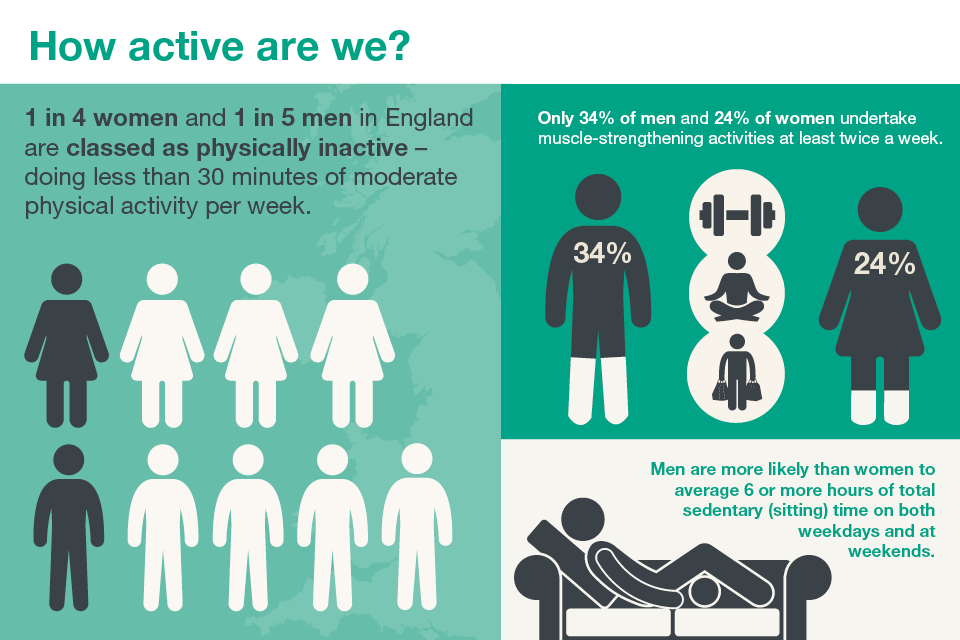
Lack of physical activity is costing the UK an estimated £7.4 billion a year, including £0.9 billion to the NHS alone.
Long term conditions such as diabetes, cardiovascular and respiratory disease lead to greater dependency on home, residential and ultimately nursing care. This drain on resources is avoidable, as is the personal strain it puts on families and individuals.
The benefits of physical activity
The first Sports Strategy in 13 years heralds a new approach which shifts the balance of investment, for the first time, to focus more on encouraging inactive and underrepresented groups to become more active. This is where the greatest individual, community and economic gains can be made.
Any physical activity is better than none. Start small and build up gradually. As little as 10 minutes of moderate physical activity at a time provides physical and mental health benefits.
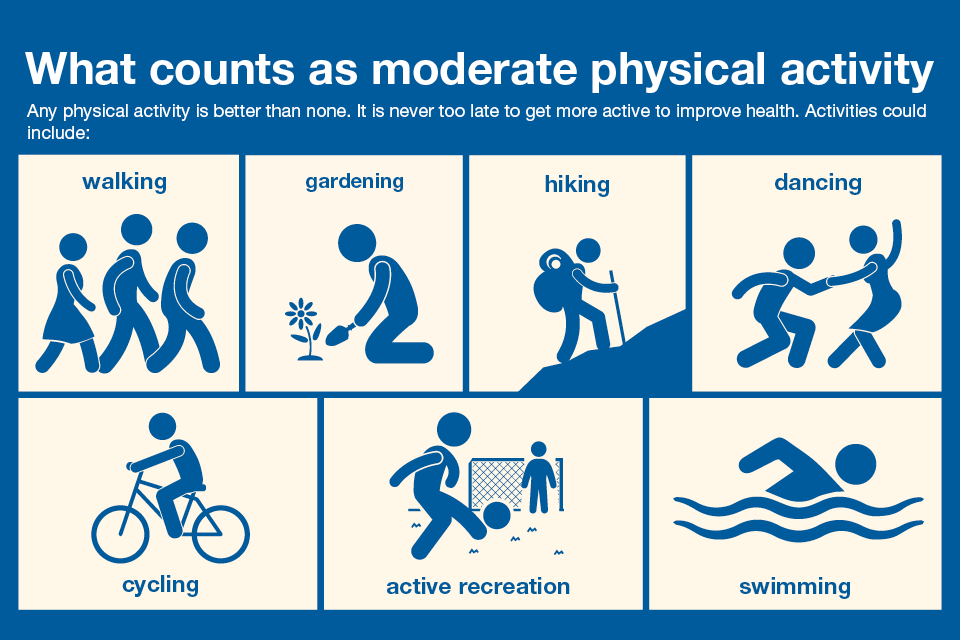
The link between physical inactivity and obesity is well established. With more than half of adults in England currently overweight or obese, everyone can benefit from being more active every day.
It is important that physical activity is not, however, framed as just an option for combating obesity.
Low physical activity is one of the top 10 causes of disease and disability in England.
Persuading inactive people (those doing less than 30 minutes per week) to become more active could prevent one in ten cases of stroke and heart disease in the UK and one in six deaths from any cause. In fact it’s often said that if physical activity was a drug it would be classed as a wonder drug.
Regular physical activity can help to prevent and manage over 20 chronic conditions and diseases, many of which are on the rise and affecting people at an earlier age; 1 in 3 of the working age population have at least 1 long term condition and 1 in 7 have more than one.
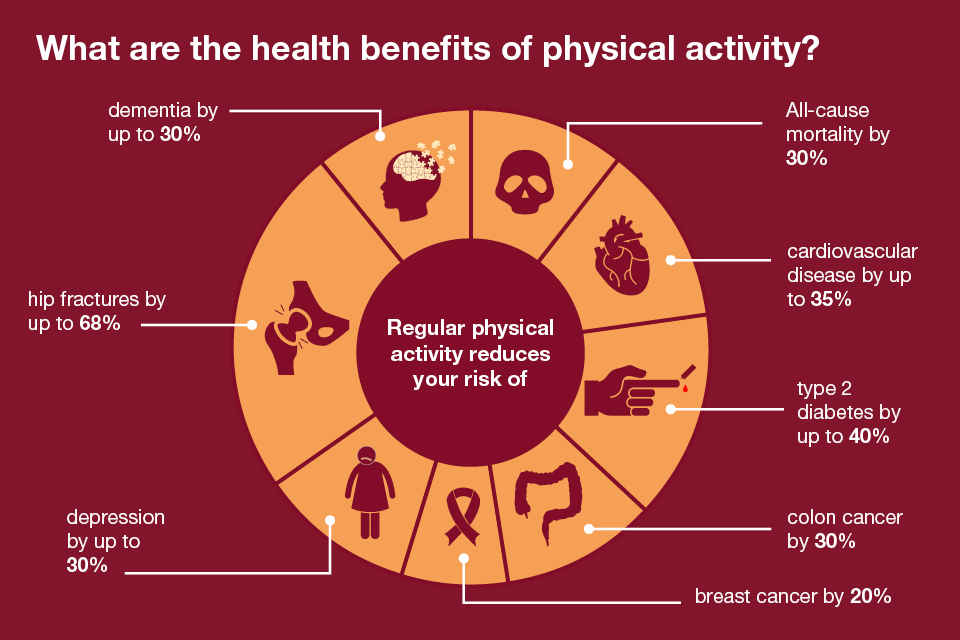
The National Institute for Health and Care Excellence (NICE) has a number of clinical pathways that highlight the role of physical activity in preventing and managing illness.
Physical activity and cancer
Physical activity can play a critical role across all elements of cancers; prevention, treatment, recovery and reducing the risk of recurrence.
A study on Cancers attributable to inadequate physical exercise in the UK in 2010 estimates that around 1% of cancers in the UK (around 3,400 cases every year) are linked to people doing less than the recommended 150 minutes of physical activity each week.
The UK Chief Medical Officers’ Start active, stay active report highlights that a lack of physical activity is a risk factor for cancers of the:
- breast
- bowel
- womb
Physical activity and risk of breast cancer: a meta-analysis of prospective studies reports that the more active a woman is, the more she can reduce her risk of breast cancer. For example, for every 2 hours a week a woman spends doing moderate to vigorous activity, the risk of breast cancer falls by 5%.
Physical activity can reduce the risk of bowel cancer by:
- ensuring regular bowel movements so cancer-causing substances in undigested food pass through the bowel more quickly
- reduces the levels of insulin, some hormones and some growth factors which at high levels can encourage the growth of tumours
- changing the levels of prostaglandins, which are involved in inflammation
Physical activity, sedentary behaviours, and the prevention of endometrial cancer found that being active can reduce the risk of endometrial cancer, with active women having around 30% lower risk than inactive women. It is believed that physical activity could lower the risk of womb cancer by reducing oestrogen levels in the blood as well as the amount of circulating insulin.
Physical activity is also important for people diagnosed with cancer and cancer survivors. Physical activity after treatment for cancer can help to reduce:
- the impact of some side effects
- anxiety
- depression
- fatigue
- impaired mobility
- weight changes
Macmillan has estimated that there are 2 million cancer survivors in the UK and around 1.6 million do not meet the recommended levels of physically active.
Physical activity and mental health
Physical activity can boost mental wellbeing and help reduce social isolation, a risk factor for depression.
The link between physical activity and depression is well established. Physical inactivity and depression in the community: evidence from the Upper Bavarian field study found that people who are inactive have 3 times the rate of moderate to severe depression of active people. NICE guidelines CG90 recommends a programme of physical activity for people with mild depression.
Other positive outcomes of physical activity include:
- a sense of purpose and value
- a better quality of life
- improved sleep
- reduced stress
Physical activity and health inequalities
A number of common health inequalities exist that can prevent adults from meeting the recommended levels of physical activity. These factors should be taken into consideration when designing activities to promote physical activity in adults.
Socio-economic status
People living in the least prosperous areas are twice as likely to be physically inactive as those living in more prosperous areas.
The South East of England has the highest proportion of men and women meeting the recommended levels of physical activity. The North West of England has the lowest.
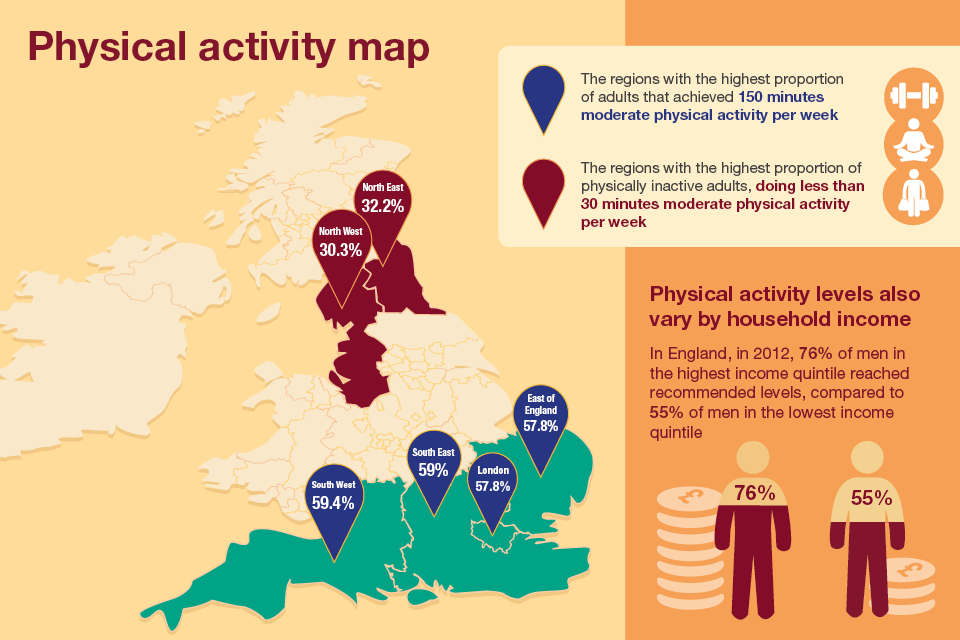
Age
Physical activity is vital for maintaining good health across the life course, and it is never too late to get more active and receive the health benefits. However, physical activity declines with age. Furthermore there are specific transition points that cause adults to reduce their activity, such as increased work commitments, time spent commuting and parenthood.
Disability
Disabled people are half as likely as non-disabled people to be active. Only 1 in 4 people with learning difficulties take part in physical activity each month compared to over half of those without a disability.
The CMO physical activity guidelines can be applied to disabled adults, and should be adjusted for each individual, based on that person’s exercise capacity and any special health or risk issues.
Race
Many minority ethnic groups have lower rates of physical activity participation and do not achieve the recommended levels of physical activity. This is most pronounced for Bangladeshi and Pakistani women, with only 11% of Bangladeshi and 14% of Pakistani women reportedly undertaking the recommended amounts of physical activity compared to 25% in the general population.
Gender
Men are more active than women in virtually every age group. Sport England’s This Girl Can campaign was created in response to research that revealed that there are 2 million fewer active women than men in the UK. The campaign has inspired 2.8 million women to be more active in the year since its launch in 2015.
Sexual orientation and gender identity
Half of all lesbian, gay, bisexual and transgender people say they would not join a sports club, twice the number of their heterosexual counterparts.
How we can increase population physical activity
PHE’s national physical activity framework, Everybody active, every day, identifies 4 areas for local and national action, based on international evidence of what works and co-produced with over 1,000 local and national stakeholders.
1. Active society
People are more likely to be active if it is seen as ‘normal’, and if their friends and peers are also active. Large, community-wide campaigns have been effective in increasing physical activity, but only when supported by local level community activities.

PHE’s One You campaign supports adults to improve lifestyle behaviours and contains advice for encouraging physical activity at a local level. A range of personalised tools are available via the How Are You online quiz, which has been completed by over 1 million people since it launched in March 2016.
The One You Couch to 5k phone app has been designed to help get people off the couch and running in just 9 weeks.
Use the This Girl Can toolkit to create local promotional materials to support the campaign and encourage greater physical activity among women. The toolkit offers access to the logo, partner images and branding guidelines.
2. Moving professionals
1 in 4 patients would be more active if advised by a GP or nurse and very brief advice on physical activity has been shown to be effective. Therefore, health and social care professionals and volunteers can play a significant role in supporting people through incorporating physical activity within an ‘every contact counts’ approach.
Physical activity: brief advice for adults in primary care from NICE recommends that those working in primary care should identify adults who are not currently meeting the UK physical activity guidelines. This could be done:
- when the opportunity arises during a consultation with a primary care practitioner
- while people are waiting as part of a planned session on management of long-term conditions
The guidance stresses that it is important not to rely on visual cues but to use validated tools such as the General practice physical activity questionnaire (GPPAQ) to assess physical activity levels.
NHS Health Check, aimed at adults in England aged 40 to 74, presents an excellent opportunity to discuss physical activity, as recommended by the NICE quality standard Physical activity: for NHS staff, patients and carers. The check includes a question on physical activity which can help health professionals identify those who need to be doing more.
Another opportunity for health professionals to discuss physical activity is as part of the NHS Diabetes Prevention Programme (DPP). This was launched by PHE, NHS England and Diabetes UK in March 2015 across 7 pilot sites, which trialled different models of finding people known to be at high risk of the condition and helping them eat well and become more active. The DPP will be expanded to 27 areas across England during 2016.
Professional learning
PHE has published a suite of free, CPD e-learning modules on physical activity in the treatment of long-term conditions, and on motivational interviewing in brief consultations.
PHE has also been piloting peer-to-peer Physical activity clinical champions teaching programme. This provides free structured training, to health professional by health professionals, to improve the understanding of physical activity in clinical practice so they can integrate very brief advice into their day to day clinical practice.
To date there have been 6 pilot regions focussing on doctors. The scheme is now being rolled out across the country and expanded to allied health professionals.
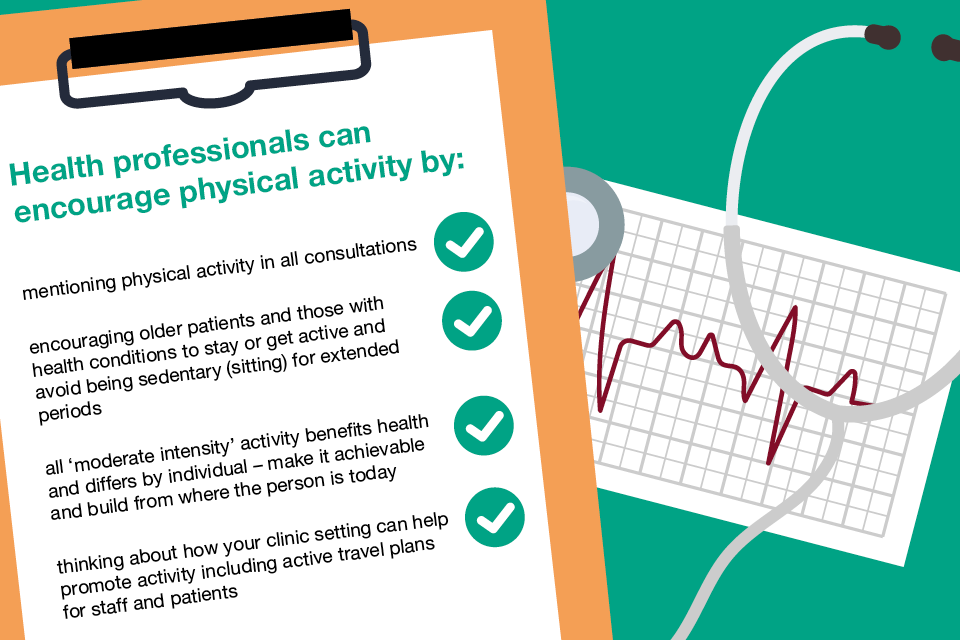
3. Active environments
Environment shapes behaviour and this has been a major factor in discouraging people from activity. Our homes, workplaces and local environments have been shaped to make it difficult to be physically active.
For most people, the easiest and most acceptable forms of physical activity are those that can be incorporated into everyday life, such as walking or cycling. But our neighbourhoods and towns and studies have largely been designed around the car.
Switching more journeys to active travel will improve health, quality of life and the environment, and local economy, while at the same time reducing costs to the public purse.
Pedestrians, cyclists, and users of other modes of transport that involve physical activity need the highest priority when developing or maintaining streets and roads.
This can mean:
- re-allocation of road space to support walking and cycling
- restricting motor vehicle access
- introducing road-user charging and traffic-calming schemes
- creating safe routes to schools
Improving or adding green spaces and tree cover improves air quality as well as making spaces feel more welcoming. Such changes have prompted substantial shifts from car transport to walking and cycling.
Small-scale improvements can also encourage movement, such as good street lighting or improved road crossings.
PHE and Sport England have produced guidance on active design which looks at the opportunities to encourage and promote physical activity through the design and layout of the built environment.
This includes advice on the 10 principles of active design which will optimise opportunities for active and healthy lifestyles.
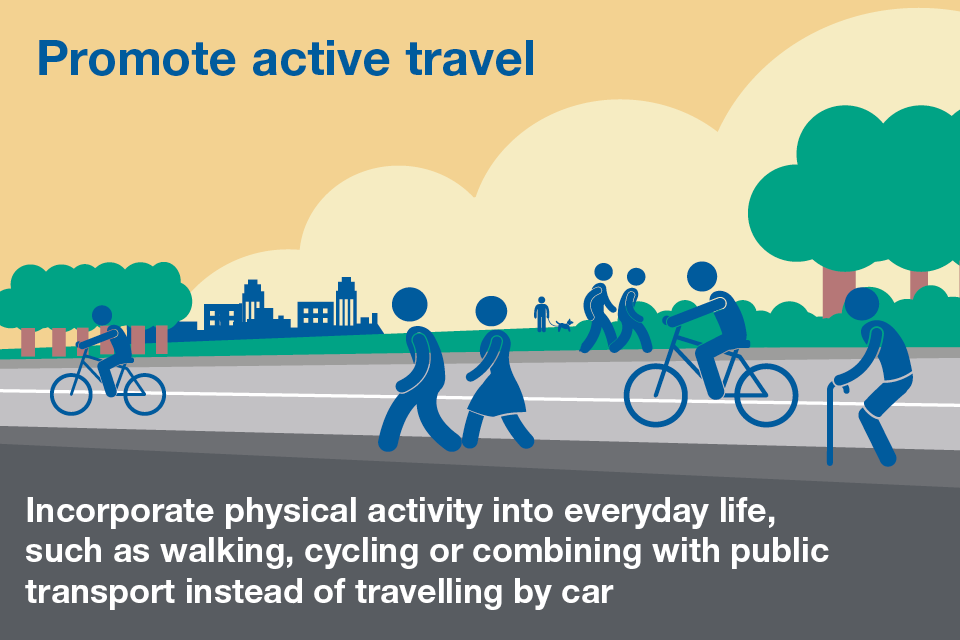
NICE has produced a suite of guidance on physical activity and the environment, to support increased levels of physical activity including:
- the promotion and creation of physical environments
- physical activity in the workplace
- walking and cycling
Features of the built environment that have an impact on physical activity include:
- location, density and mix of land use
- street layout and connectivity
- physical access to public services, employment, local fresh food
- safety and security
- open and green space
- affordable and energy-efficient housing
- air quality and noise
- resilience to extreme weather events
- community interaction
- transport
Building design can encourage movement through and around the building, as well as between sites. NICE recommends that campus sites, such as hospitals, encourage active travel between sites by creating pleasant and accessible routes for walking and cycling.
Healthy at work
With 70% of the adult population in employment, there is strong evidence that workplace physical activity programmes are effective. These can include:
- flexible working policies and incentive schemes
- policies to encourage employees to walk or cycle
- information, ongoing advice and support
- independent health checks focused on physical activity
Workplaces can introduce practical measures to encourage active travel such as showers for cyclists.
There is strong evidence for the effectiveness of interventions to increase stair use. Simple signs near the lifts can point out that 2 minutes of stair-climbing each day could burn enough calories to eliminate the weight an average adult gains each year.
Encouraging physical activity is an important part of the Workplace Wellbeing Charter.
4. Moving at scale
The role for local authorities
Local authorities can encourage local leadership and action to increase physical activity and reduce inactivity through health and wellbeing boards, ensuring that physical activity is included in joint strategic needs assessments and joint health and wellbeing strategies. They should also weave their approach to physical activity across their relevant functions, including sport and leisure, planning, transport, social care and economic development.
Connections should be made to:
- local spatial and neighbourhood plans
- transport plans
- community sports and physical activity plans
- clinical commissioning group strategic plan
- economic regeneration plans
Local authorities should work with:
- Local Enterprise Partnerships to invest in cycling and walking infrastructure to support local businesses with active travel and active retail
- leisure, fitness and sport providers to maximise the potential of local physical activity assets
- community groups to activate and maximise the potential of parks and green spaces
Local authorities can develop programmes of personalised travel plans. These aim to encourage people to change their travel habits by providing them with detailed information of possible alternatives. They involve identifying people who wish to make changes, providing them with information, and supporting them in making changes.
PHE has produced a briefing for local authorities on Working together to promote active travel.
Use PHE’s Public health and outcomes framework to identify the percentage of physically active and inactive adults in your local area.
A range of population-level surveys of physical activity provide further detail of the picture at national, regional and local levels. These include:
PHE’s Standard evaluation framework for physical activity aims to describe and explain the information that should be collected by local authorities in any evaluation of an intervention that aims to increase participation in physical activity. It is aimed at interventions that work at individual or group level, not at population level.
The role for NHS commissioners
Clinical commissioning groups (CCGs) can inspire local action by NHS staff by showing national leadership on physical activity and emphasising the potential return on investment for individuals and at a population level for being active every day.
Commissioners should:
- integrate the ambition to increase physical activity through clinical commissioning pathways into the NHS strategic plan and delivery action plans
- demonstrate local leadership to activate networks of professionals to promote physical activity in clinical care, such as supporting local physical activity champions in primary and secondary care
NICE’s return on investment tool can help commissioners when making decisions about physical activity programme planning at local and sub-national levels.
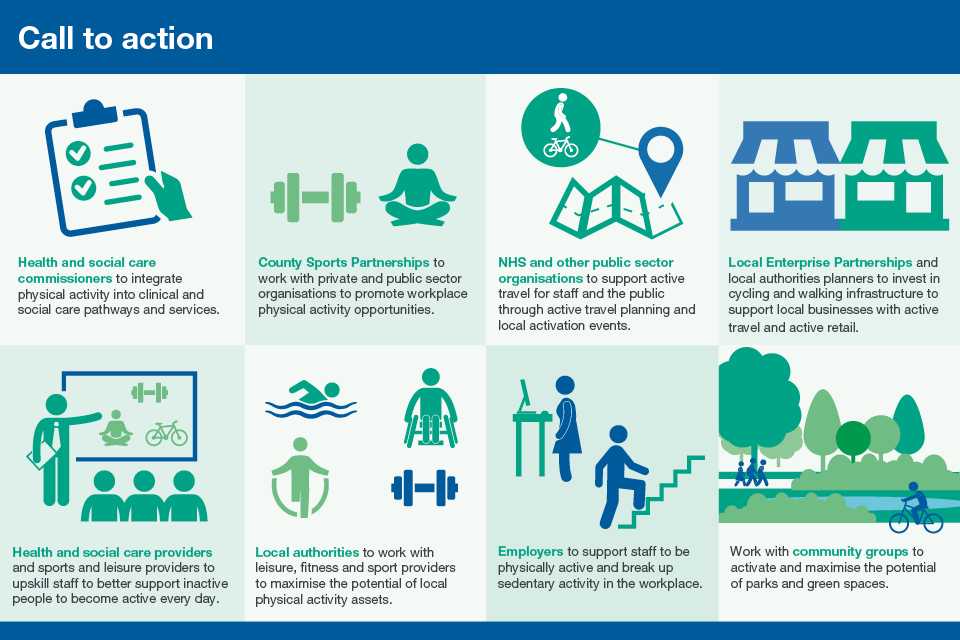
The role for healthcare professionals
Healthcare professionals should:
- know the needs of individuals, communities and populations related to physical activity
- think about the resources and the services available in the health and wellbeing system to promote physical activity
- understand specific activities or interventions which can prevent physical inactivity, protect through physical activity, and promote healthier more active lifestyles
Healthcare professionals can have an impact on an individual level by:
- delivering high-quality brief interventions for physical activity behaviour change; these should be non-judgemental and tailored to the individual using motivational interviewing techniques
- being familiar with the important messages
- being familiar with local referral pathways to exercise on referral schemes
- being familiar with local physical activity options
- becoming a physical activity role model; increasing your own activity levels will improve your own health and make it easier for you to discuss physical activity with other people
The role for the sports and leisure sector
UKactive and the Sport and Recreation Alliance have outlined the important role for the sport and leisure sector. The sector can engage inactive adults by:
- thinking about how your programming targets and engages inactive people; this is a potential new market for members or /participants and how you market and promote your service is key to whether they see it as something for people like them
- engaging with the local population (including inactive people and those not using your facilities) in the development of physical activity programmes and the development of the marketing and engagement approach
- thinking about how to offer targeted sessions for different communities as well as inclusive activities and consider using tools like an equality impact tool to consider whether your offer really is accessible to all
